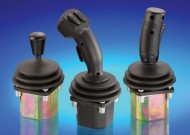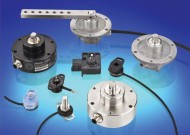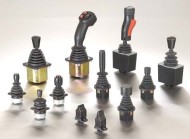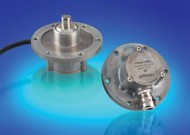 With a legacy spanning more than 50 years, Penny + Giles is a recognised leader in the design and manufacture of joysticks, sensors and industrial solenoids. It has extensive experience in providing solutions for monitoring and control under extreme operating conditions and its range of joystick controllers and position sensors are used throughout the off-highway industry, from agricultural vehicles and backhoe excavators, to lift trucks and powered access platforms.
With a legacy spanning more than 50 years, Penny + Giles is a recognised leader in the design and manufacture of joysticks, sensors and industrial solenoids. It has extensive experience in providing solutions for monitoring and control under extreme operating conditions and its range of joystick controllers and position sensors are used throughout the off-highway industry, from agricultural vehicles and backhoe excavators, to lift trucks and powered access platforms.
Joystick Controllers
Penny + Giles’ range of finger- and hand-operated joystick controllers are designed and developed for smooth, precise control of critical functions where a Human-Machine Interface (HMI) is required. Available in single, dual or multiple axis configurations and with ergonomic handle styles to enable superb proportional control, each model has a range of selectable options for the most comprehensive joystick-to-application matching.
An option that is proving popular with many OEM’s, and one that Penny & Giles believes is the future of joystick controller technology, is the use of contactless, Hall effect sensors. These sensors not only provide reliable and accurate output signals and benefit from a second output to enable error checking of system integrity but also, for example, triple the operational life of the company’s JC6000 from an already impressive five million operations, to more than 15 million!
In fact, this combination of joystick controller and contactless sensor is already proving popular for a number of lift truck applications where maintaining smooth proportional control is essential.
Quoting an example: Penny & Giles had historically supplied a potentiometer-based, multi-axis JC6000 joystick controller for a container handling application, but has more recently worked with its customer to develop a Hall effect version that delivers improved performance and reliability with its current vehicle control system. In order to meet the specification demanded of the control system, Penny + Giles also reconfigured the output characteristics of the Hall sensor to mimic a potentiometer-based joystick. As well as controlling the boom angle and reach of the boom arm, the joystick also controls the spreader arm, which can clasp, rotate or shift the container from left to right.
 While improving operational life, the use of Hall effect sensors means that a joystick controller’s mechanical life is now the limitation rather than the sensor. However, by improving material selection and lubrication Penny + Giles now also offers joystick controllers with repeatable performance and very little degradation over their defined mechanical life.
While improving operational life, the use of Hall effect sensors means that a joystick controller’s mechanical life is now the limitation rather than the sensor. However, by improving material selection and lubrication Penny + Giles now also offers joystick controllers with repeatable performance and very little degradation over their defined mechanical life.
In future, Penny + Giles will be adopting Hall sensing technology not only to improve life expectancy, but also the programmability of the sensor itself by exploiting the circuit board design and the way its joystick controllers are calibrated.
Using multiple-point-programming the company is, for example, able to create a non-linear output by manipulating the data and voltage from the joystick. More programmable points within the characteristics of the sensor benefit customers by making joystick controllers more repeatable unit-to-unit, with more consistency across the delivery of product. This means that the customer can specify a configuration that is factory set by Penny + Giles and the customer won’t have to re-configure its control system for a specific application.
A relative newcomer to the JC6000 range is a heavy-duty, single-axis version that was designed and developed in response to customer requests for a higher-strength, return-to-centre joystick. This addition to the range is ideal for use in arduous conditions or applications such as wheeled loaders and other heavy machinery where high ‘across axis’ loads can be an issue.
For a particular access lift application, Penny + Giles developed a Can Open-based version of the heavy-duty JC6000 to a customer’s specification that required a generic solution circuit board that could be programmed in different ways.
The increased strength of the new heavy-duty JC6000 has been achieved by redesigning the body casting, which the company claims has increased across-axis fatigue life by a factor of five. The heavy-duty version will also use a new gaiter designed to accommodate the increased strength of the body casting.
The heavy-duty JC6000 is available with long-life potentiometer track sensors with auxiliary contacting directional switch tracks, single/dual non-contact Hall effect sensors (or a combination of both), Can (J1939) and Can-Extended input interfaces and is designed to share all the standard JC6000 handles and grips.
Other popular JC6000 models include single-axis friction-hold versions for equipment requiring high manoeuvrability; and CAN-bus output options enabling OEMs to improve control systems in off-highway vehicles.
In fact, with choices from Hall effect sensors to potentiometer tracks; handles and grips; single-, dual- and multiple-axes; and various IP ratings, Penny + Giles claims that there are over one million configurations available for its JC6000 joystick controller range.
The company’s most recent introduction – already adopted for a new scissor lift application – is the single-axis JC1500. This new joystick controller has evolved from the JC6000 (its first-generation rugged Hall effect joystick controller) and is designed for heavy duty applications such as specialist off-highway vehicles and aerial work lifts and platforms, especially where reliability and strength are required.
The rugged, low-profile design of the JC1500 (53mm under-panel depth) complements the existing JC150 range of potentiometer-based joysticks. In addition, for easy and modification-free replacement or upgrade, the JC1500 uses the same panel mountings and is designed to share the same range of handles and grips, as JC150 and JC6000 models.
 The JC1500 has fully-enclosed, IP69K-rated electronics in the base of the joystick controller. This means that the customer’s own control panel connector needs to be similarly specified to maintain the high level of ingress protection. The range of handles also includes an option with IP69K protection to ensure that the joystick controller can be supplied with maximum protection both above and below the panel.
The JC1500 has fully-enclosed, IP69K-rated electronics in the base of the joystick controller. This means that the customer’s own control panel connector needs to be similarly specified to maintain the high level of ingress protection. The range of handles also includes an option with IP69K protection to ensure that the joystick controller can be supplied with maximum protection both above and below the panel.
Additional features include spring-to-centre or friction-hold lever actions; lock and detent features; 5Vdc or 9-30Vdc supply; dual-channel output with optional ramp directions; analogue (Vdc) or digital (PWM) outputs; and an operating range from -40°C to +85°C.
Penny + Giles is also developing the JC1500 concept (rugged and heavily protected) to produce a new heavy-duty dual-axis joystick controller with all-round, high-strength features that will make it ideal for applications such as skid-steer loaders, where operators typically use hydraulic joysticks. The most significant benefit of the ongoing joystick controller developments at Penny + Giles is the dramatic increase in joystick lever strength, which means that previously excluded applications can now consider using electronic joysticks instead of generic hydraulic versions.
Position Sensors
Penny + Giles’ extensive range of rotary position sensors offer angle measurements from 10° to 360°. Like its joystick controllers, they use Hall effect, inductive or potentiometric technologies, all packaged in compact or rugged housings, with environmental protections to IP68 and IP69K. The dual-output, contactless range has been specially developed to meet the harsh operating requirements in heavy-duty industrial position sensing applications such as construction, agricultural and utility vehicles.
Designed with 21st century applications in mind, Penny + Giles contactless rotary position sensors use the latest advances in 12bit Hall effect sensing technology and are factory-programmed to provide OEM’s with a variety of previously unavailable options. These include single- or dual-redundant outputs, clockwise or anticlockwise rotation and measurement angles from 0-20° to 0-360° in 1° increments.
Most models can withstand operating temperatures between -40°C and +140°C (+170°C for 72 hours for NRH/TPS models); are tested to resist severe shock and vibration; and have an EMC immunity of 100V/m.
The sensors are designed to operate from a 5Vdc regulated or 9 – 30Vdc supply; and outputs can be PWM or analog voltage (nominal 0.5 – 4.5Vdc) over the measurement range, with clockwise or anticlockwise shaft rotation. A choice of 341 different electrical angles from 20° to 360° are possible and 12bit resolution (0.025%) is available over the selected measuring range with a non-linearity better than ±0.4% and temperature stability better than ±50ppm/°C. The sensor’s analog output option has a very low output noise level of less than 1mV rms.
Having successfully introduced Hall effect joystick controllers for the container handling application mentioned earlier, Penny & Giles is now supplying its SRH502P contactless rotary sensor for a closed-loop boom angle application on the same vehicles.
 The sensor is mounted where the boom pivots on the truck and is used to measure the angle controlled by a Penny & Giles JC6000 joystick controller. While the joystick controls the hydraulic lifts the sensor provides feedback on the angle it has achieved.
The sensor is mounted where the boom pivots on the truck and is used to measure the angle controlled by a Penny & Giles JC6000 joystick controller. While the joystick controls the hydraulic lifts the sensor provides feedback on the angle it has achieved.
The advantage of Hall effect technology over the previously specified single-output potentiometer-based sensor, is the elimination of signal noise due to potentiometer track wear, which could cause problems with position, angle, etc. The Penny + Giles SRH502P was specified because it offers the same mounting detail as the previously used sensor and therefore required minimum customer engineering.
Initially only used on new-build vehicles, the sensor is now retrofitted for all warranty claims and has been life- and compliance-tested, and subsequently qualified, by the customer.
New levels of sophistication
The latest developments in sensing and control system technology are bringing a whole new level of sophistication to vehicle controls, resulting in much more efficient operation. Highly reliable signals from the latest joystick and sensor developments, combined with intuitive control system software, mean that off-highway vehicles and their equipment can be tuned to optimise performance to individual applications. At the touch of a few buttons, routine operations can be performed at high speed with minimal fatigue, delivering considerably better productivity from both vehicle and operator.
Involving component suppliers such as Penny + Giles at the earliest possible stage of vehicle development often produces the most cost-effective solution in the shortest possible development time. This is achieved by combining Penny + Giles’ vast experience of the type and layout of equipment controls with the more subjective input of OEM engineering and marketing departments.
Tel: 01202 409409





Comments are closed.